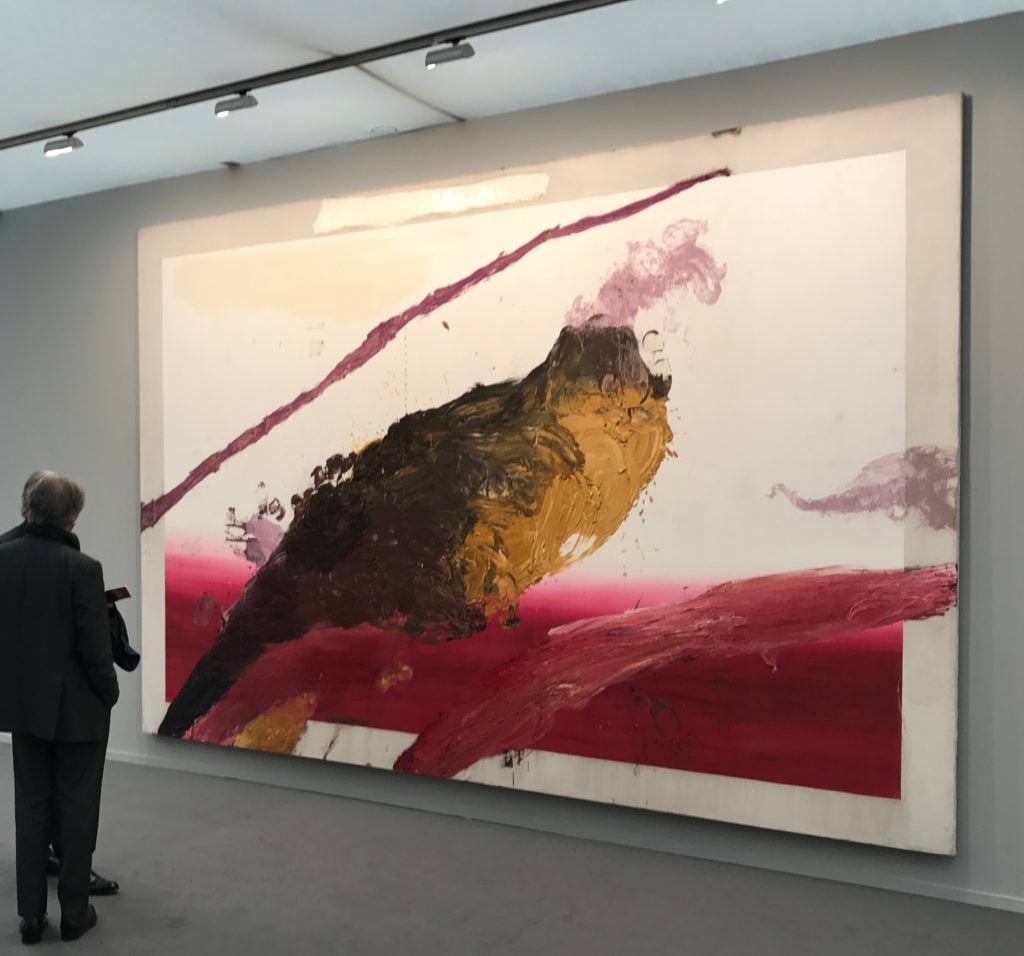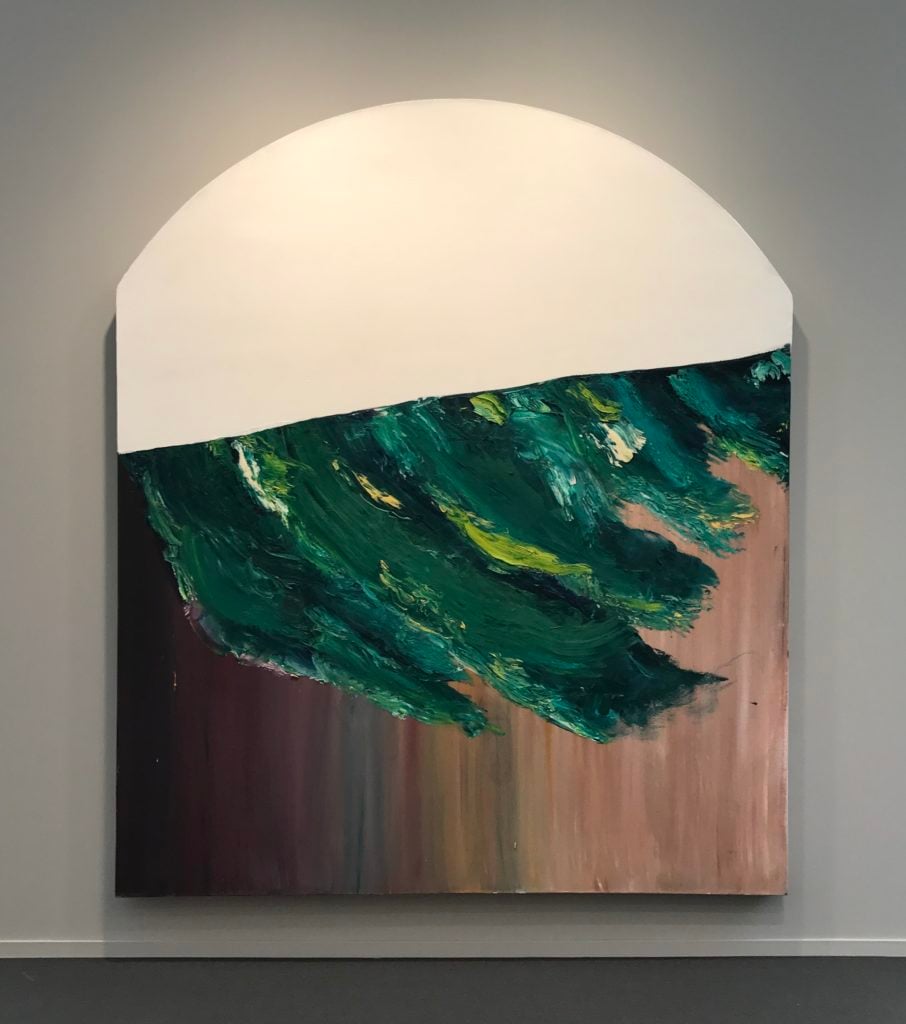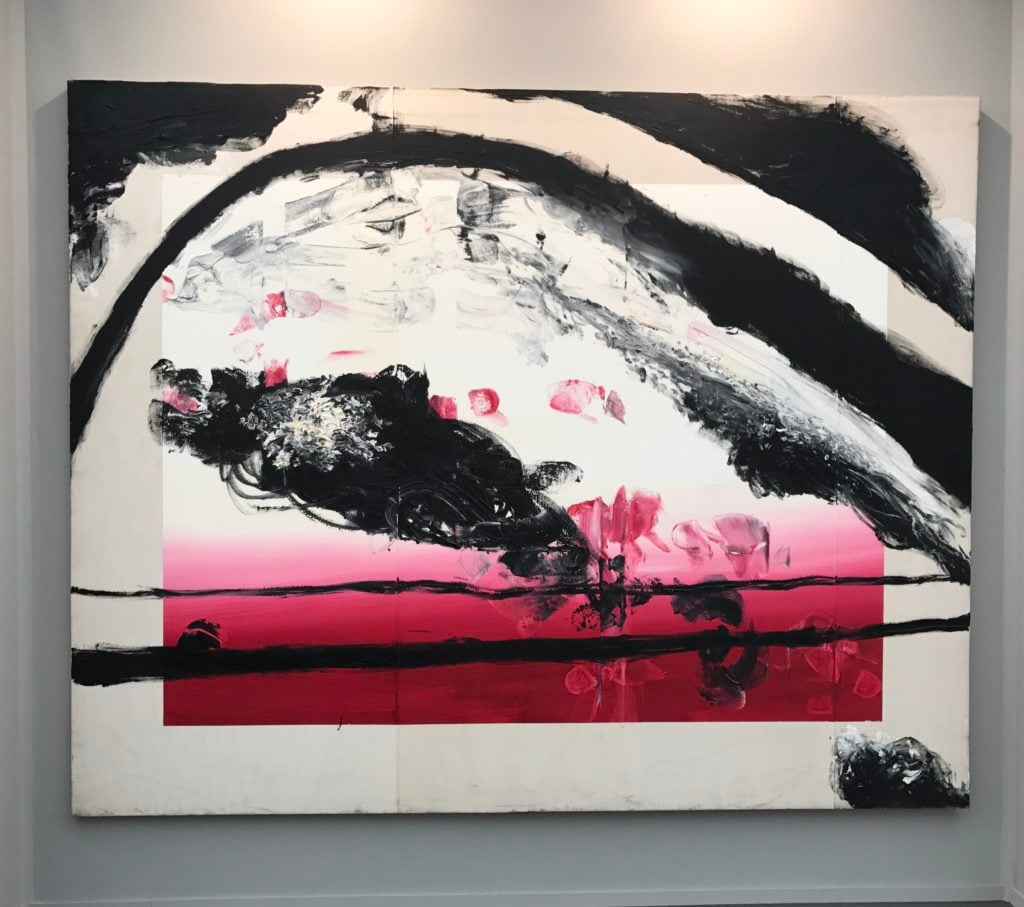Art Fairs
‘We’re Stripping Away All the Noise’: The Great Julian Schnabel Reboot Continues at Frieze Masters
At Blum & Poe, the effort is to refocus attention away from "the personality."

At Blum & Poe, the effort is to refocus attention away from "the personality."

Andrew Goldstein

At the heart of Frieze Masters, amid the quiet, decorous authority of the €4 million Parmagianinos and $13.5 million Légers, whirrs the gears of a more newfangled art-market contraption: the Julian Schnabel comeback machine. Occupying the tastefully curated booth of Los Angeles’s Blum & Poe gallery, six of the artist’s abstractions—by far the largest paintings in the fair—represented the latest stage of a concerted campaign to elevate the film-art-and-interior-design impresario beyond his bombastic tabloid reputation and reposition him as a serious art-historical figure.
The paintings, arrayed against walls painted a somber grey, have never been seen before. Full of pinks, greens, reds, whites, and browns, they were made in 1994 between New York and Montauk, where Schnabel stretched them on the ground outside and vigorously applied paint with his feet and hands as “the din of rain hammered into the surface pigments,” according to wall text by Alison Gingeras (the former curator at François Pinault’s Palazzo Grassi), who adds that their composition is inspired by “the use of gradient colors in the design of Japanese calendars.”

Julian Schnabel’s 1st Landscape Without Gravity, 1994
Priced between $325,000 and $525,000, the paintings certainly provide terrific dollar-per-square-inch value at the fair. Despite his fame, Schnabel has only once broken the million-dollar mark at auction, at Sotheby’s in May 2014.
Tim Blum, the affable co-owner of the LA gallery, said the works were “as good as Julian gets,” and “come from a very fecund time for him.” Nonetheless, when it came to sales, “our expectations are very reasonable,” he explained. The real point is to display a body of work that’s new to people familiar with Schnabel’s well-known plate, tarp, and velvet paintings, and to force them to take a fresh look at the artist.
“We’ve been working with Julian for a couple years now, and we’re trying to reboot-slash-shift the context in which he resides,” Blum said. “We’re stripping away all the noise that defines a figure like Julian. Nobody is coming in here thinking about the plates or the money or the Mary Boone. This is him as his authentic self, and when Julian is Julian the Authentic Artist, he performs at his highest capacity and potential. But sometimes the personality can get in the way.”

Julian Schnabel’s Last Attempt at Attracting Butterflies, 1994
Of course, that personality—the repute of the larger-than-life pajama-clad emperor of Palazzo Chupi who told New York magazine “I’m the closest thing to Picasso that you’ll see in this fucking life” in 1992, two years before these canvases were painted—is more or less indistinguishable from the artist himself. When ribbed about how much easier the other Frieze Masters galleries had it, working with the estates of long-departed artists, Blum laughed ruefully.
Currently, Schnabel is off in France filming his latest movie, a biopic of Vincent van Gogh starring Willem Dafoe. Next April, the artist will have a solo show at the Legion of Honor in San Francisco, and he also has an upcoming show at Galerie Max Hetzler alongside Albert Oehlen, his friend of 30 years who spent the 1980s reacting against Neo-Expressionism as Schnabel epitomized it in New York. This month, he also has a solo presentation at Almine Rech in New York. These shows, Blum said, “will continue to shift Julian’s reputation in interesting ways.”
Across the aisle, Marc Glimcher of Pace Gallery, couldn’t help but be amused. “I see you’ve noticed we have two booths!” he said. Having represented Schnabel since he decamped from Gagosian last year, Pace is now doing yeoman’s work to reshape the narrative around the artist, collaborating closely with Blum & Poe. “We talk all the time,” Glimcher said.
At the fair, however, while the LA gallery did the heavy lifting, Glimcher instead presided over a tender tribute to Saul Steinberg, the great New Yorker artist. A longtime member of the Pace stable, Steinberg’s erudite and witty drawings filled the booth along with furniture from his studio, including two chairs where a much younger Glimcher used to chat with the man he calls “the most well-read person I’ve ever met, a towering figure.”
“I always use this fair for works on paper,” Glimcher said. “It’s a place where people can actually see the art and think about it.” It remains to be seen what collectors and curators think of the Schnabel renaissance being marketed across the way.